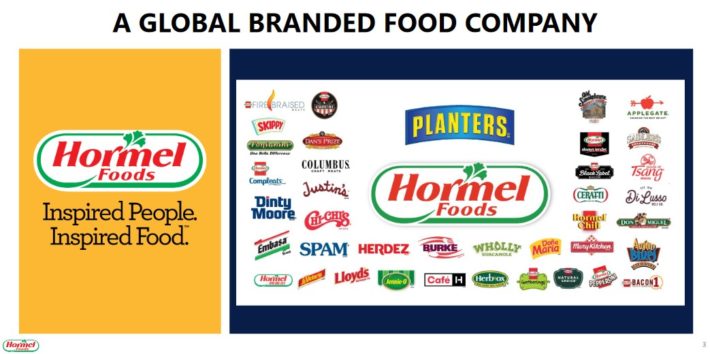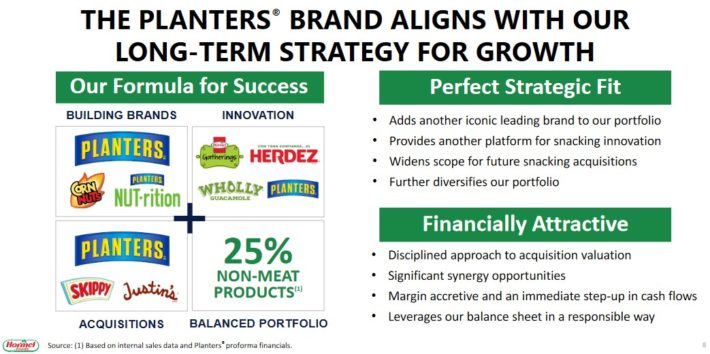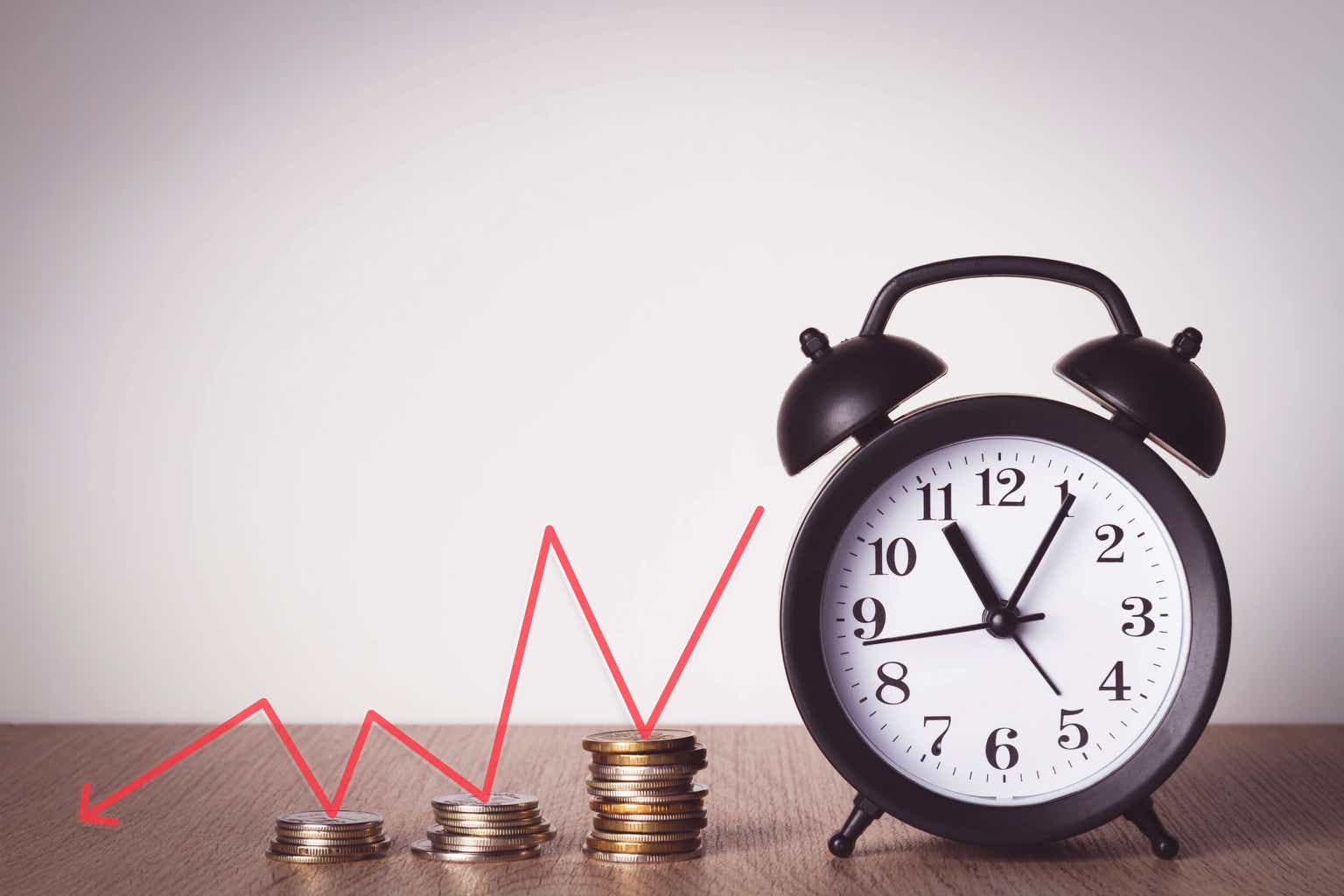Updated on February 3rd, 2023 by Samuel Smith
As the saying goes, slow and steady wins the race. This comes to mind when discussing the Dividend Aristocrats, a select group of just 68 companies in the S&P 500 Index, each with at least 25 consecutive years of dividend increases.
The Dividend Aristocrats are among the best stocks for investors looking to generate long-term wealth that can last for generations. With this in mind, we created a full list of all Dividend Aristocrats, along with relevant financial metrics such as price-to-earnings ratios.
You can download your full Dividend Aristocrats list by clicking on the link below:
Hormel Foods (HRL) is the very definition of a slow-and-steady stock. While it will not make investors rich overnight, it has steadily built wealth for its shareholders over many years.
Hormel operates in a stable industry and has many strong brands. It has also rewarded shareholders with 57 consecutive years of rising dividends. Hormel has paid dividends for over 90 years in total.
Not only is Hormel a Dividend Aristocrat, but it is also a Dividend King as well thanks to its outstanding track record of returning cash to shareholders. The Dividend Kings have increased their dividends for 50+ consecutive years. You can see all the Dividend Kings here.
This article will discuss why Hormel is a high-quality dividend growth stock, and provide some perspective on the company’s growth and valuation outlook.
Business Overview
Hormel was formed all the way back in 1891, when George A. Hormel established the Geo. A. Hormel & Company in Austin, Minnesota. Consumers took a liking to Hormel’s fresh pork products, which were a novelty at the time. In 1926, the company produced the world’s first canned ham.
Hormel has continued to grow in the decades since, and now generates ~$12.5 billion in annual revenue. It has a diverse product portfolio today, spanning several categories. Some of its major brands include Skippy, Jennie-O, Spam, Hormel, and Dinty Moore. In recent years, it has added more natural products to complement its processed offerings, such as Justin’s and Applegate.

Source: Investor Presentation
Hormel reported fourth quarter and full-year earnings on November 30th, 2022, and results were somewhat mixed. Earnings-per-share beat expectations by two cents, coming in at 51 cents. Revenue, however, fell 5% to $3.3 billion, and missed estimates by $50 million.
Organic sales were up 2%, excluding the impact of the additional week that was present in the prior year’s fourth quarter. Operating income was $367 million, up 3%. Operating margin was 11.2%, which was 80 basis points higher than last year’s Q4. Earnings-per-share were flat at 51 cents. Cash flow from operations came to $372 million, down 34% year-over-year. The company said it expects to see volatile costs and sales for the foreseeable future given supply chain constraints and inflationary pressures.
We believe the company can achieve $1.90 in earnings-per-share for 2023, which would be a marginally higher new record, if achieved. We think Hormel is on track to continue to slowly build revenue and margins moving forward thanks to improving volumes and a higher margin product portfolio.
Growth Prospects
Hormel has an extremely impressive history of generating consistent growth from year to year, regardless of the broader economic climate. This speaks to the company’s strong brands and its staying power during recessionary periods.
Hormel’s growth prospects depend upon a few different levers it can pull in the coming years. Organic growth is likely due to the company’s strong brands. In addition, Hormel has made a habit of buying its growth over the years through acquisitions.
The most recent example is Hormel’s $3.35 billion acquisition of the Planters snack nut portfolio from Kraft-Heinz (KHC). The acquisition fits perfectly into Hormel’s long-held acquisition strategy.

Source: Investor Presentation
The deal is expected to provide Hormel with a $560 million tax benefit, for a net price of $2.79 billion. The portfolio produced $1 billion in sales in 2020 and should reach Hormel’s long–term organic growth target. Hormel expects to see synergies of $50 million to $60 million annually to be realized by 2024 from the Planters acquisition.
Moving forward, we expect 6% annualized earnings per share growth over the next half decade.
Competitive Advantages & Recession Performance
Hormel has a number of operational advantages. First, it operates in a wide variety of food businesses, which are very stable. Everyone has to eat, which provides the company with a certain level of demand, even during recessions.
In addition, Hormel’s products are affordable for everyone, so stability should shine through during tough economic times.
In addition, Hormel has many strong brands, which gives the company pricing power. In all, Hormel has the #1 or #2 position in over 40 of its brands.
Its popular products make it difficult for competing food companies to take market share. In fact, Hormel has been in that enviable leadership position for years, so it is certainly a lasting advantage.
Hormel’s competitive advantages provide the company with a recession-resistant business model. Hormel’s earnings-per-share during the Great Recession are below:
- 2007 earnings-per-share of $0.54
- 2008 earnings-per-share of $0.52 (3.7% decline)
- 2009 earnings-per-share of $0.63 (21% increase)
- 2010 earnings-per-share of $0.76 (21% increase)
As you can see, Hormel experienced a mild earnings decline in 2008, then racked up two consecutive years of 20%+ earnings growth. We expect Hormel to perform very well whenever the next recession strikes.
Valuation & Expected Returns
We expect Hormel to generate an adjusted EPS of $1.90 for fiscal 2023. Based on this, the stock trades for a price-to-earnings ratio of 23.8. This is well above Hormel’s 10-year average price-to-earnings ratio. We view fair value for Hormel at a P/E of 22.
As a result, it appears Hormel is overvalued. If the P/E retraces to 22 over the next five years, it would reduce annual returns by 1.6% per year.
While the stock is not likely to see a higher valuation multiple, it can still generate somewhat positive returns from earnings growth and dividends. Including expected EPS growth of 6% and the 2.4% dividend yield, total returns are estimated at 6.8% per year.
The company’s dividend is very safe and will almost certainly continue to grow for many years, but given that the total return profile is not great, we rate Hormel a Hold.
We would be apt to upgrade Hormel to a buy if the valuation weren’t so high, but until that happens, we view it as a Hold.
Final Thoughts
Hormel has paid consecutive quarterly dividends without interruption since it became a public company in 1928. It has established one of the longest streaks of dividend increases in the market, and it is a Dividend King.
Consumer staples stocks, particularly food companies with strong brands, enjoy steady demand and pricing power. There is no question that Hormel has a strong business with a high-quality brand portfolio.
However, the stock is overvalued, meaning investors buying at this price level are likely to receive fairly unimpressive total returns. Even with projected EPS growth and dividends, overvaluation means the stock is pricing in too much growth today.
Additionally, the following Sure Dividend databases contain the most reliable dividend growers in our investment universe:
If you’re looking for stocks with unique dividend characteristics, consider the following Sure Dividend databases:
The major domestic stock market indices are another solid resource for finding investment ideas. Sure Dividend compiles the following stock market databases and updates them monthly:
Thanks for reading this article. Please send any feedback, corrections, or questions to [email protected].














